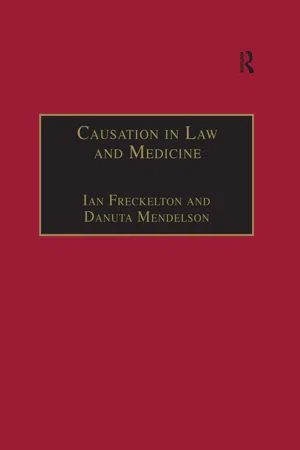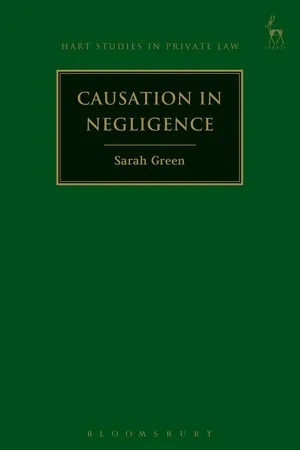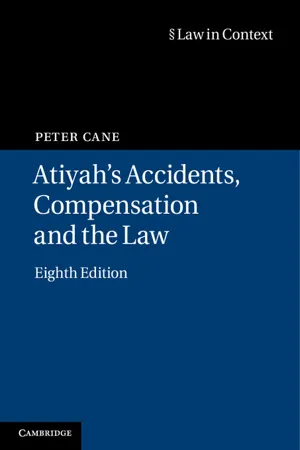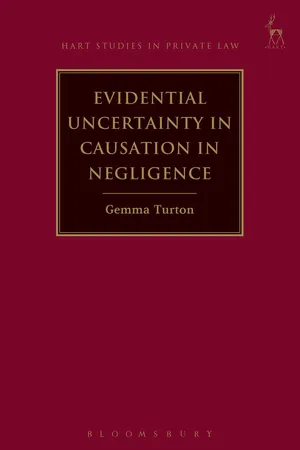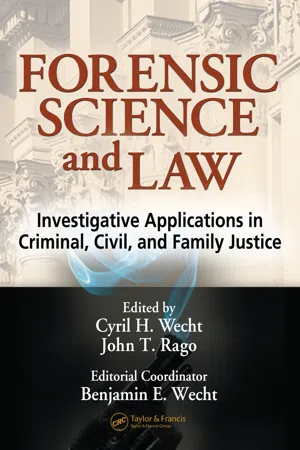Law
But for Test
The "but for test" is a legal principle used to determine causation. It asks whether the harm would have occurred "but for" the defendant's actions. In other words, it examines whether the harm would have happened anyway, regardless of the defendant's conduct. If the harm would not have occurred "but for" the defendant's actions, then the defendant's actions are considered a cause of the harm.
Written by Perlego with AI-assistance
Related key terms
1 of 5
7 Key excerpts on "But for Test"
- eBook - ePub
- Danuta Mendelson, Ian Freckelton(Authors)
- 2017(Publication Date)
- Routledge(Publisher)
March may be the bridge between two conflicting views. The first was that satisfaction of the "but-for" test exhausts the causation issue, with policy considerations being considered at a different stage of the enquiry. The second view which, I should say, has prevailed, is that the But for Test, will not of itself, usually be enough to make an act or omission a cause of damage for legal purposes.The current generation of judges is certainly not the first to grapple with the problem of causation. The common sense test must be distinguished from the last clear chance rule which is said to have been formulated in Davies v Mann. 20 The test was that if both parties were negligent, but if one had a last clear chance of avoiding the harm, that person would be solely responsible for the harm. That rule has been trenchantly criticised, not only for being an inept way of giving effect to sensible policy, but also for masquerading as a common sense test and an excuse for throwing the whole blame on the defendant. The rule was abolished with the introduction of apportionment statutes.21The High Court recently applied,22 but with heavy qualification, the "but-for" test in the context of the Trade Practices Act 1974 (Cth) which provided for an examination of whether the applicant suffered damage by the conduct of the respondent. The provisions of the statute were held to require the identification of a causal link between loss or damage and conduct done in contravention of the Act. The Court noted the problems with the "but-for" test in March v Stramare 23 but preferred to resolve the case by comparing the position of the plaintiff with the position that the party would have been in but for the contravening conduct. On the facts of the case, it was held that no loss had been suffered as a result of the misleading conduct.It is in the field of medicine, however, that causation poses special problems. I hardly need say, as Justice Kirby recently said, that causation, in the context of establishing a causal connection between medical negligence and damage, is often the most difficult task for a plaintiff in medical malpractice litigation. Fleming describes causation as "plaguing" the courts and scholars.24 But courts do not even agree on that. Justice Gaudron, in Naxakis v Western General Hospital ,25 - eBook - PDF
- Sarah Green(Author)
- 2015(Publication Date)
- Hart Publishing(Publisher)
This rather prosaic point mounts a considerable challenge to such a rights-based theory, elegant as it is in theory, as a means of deciding cases in practice. Beever Beever is another critic of the But for Test. He argues that ‘causation is centrally concerned with sufficiency rather than with necessity’, 84 and explains this conclu-sion in the following terms: Something is a cause of an effect if that something was an element of the set that was the cause of the event. To spell this out in more detail, we might say that that C is a cause of E if and only if C was a member of the set of conditions that were sufficient for E and led to E. Any test inconsistent with this definition must be mistaken. The but for, targeted 81 ibid, 137–38. 82 And the breach of duty concerned was not severally sufficient – see Ch 4 under sub-heading ‘Several Sufficiency’. See also Stapleton, ‘Unnecessary Causes’, above n 55 at 55. 83 Stevens, Torts and Rights , above n 71 at 133. 84 A Beever, Rediscovering the Law of Negligence (Oxford, Hart Publishing, 2009) 417. 28 The Necessary Breach Analysis and But For Causation but for 85 and NESS test are examples. This is because they adopt, in different ways, the strategy of using a test of necessity to determine whether an alleged event was a member of the set of events that led to an effect. But there is no reason to think that necessity is an appropriate test. In fact, in the light of the problems that flow from overdetermina-tion, there is every reason to think that it is not. Accordingly, we must conclude not only that the but for, targeted but for and NESS tests are flawed but that any test incorporat-ing necessity must also be. 86 In common with other critics of the But for Test, Beever is here evaluating it as a means of identifying a generic, physical cause, as opposed to a cause of specific legal relevance. - eBook - ePub
- Allan Beever(Author)
- 2007(Publication Date)
- Hart Publishing(Publisher)
In determining factual causation, we are interested in whether the defendant’s negligence was a causal factor in, or causally contributed to, the claimant’s injury. It makes no difference whether the factor was substantial or whether the contribution was material. To take the clichéd example, if the wings of a butterfly in Brazil caused a hurricane in Texas, then the butterfly was a cause of the hurricane of course. But it would not seem right to say that it was a substantial factor in, or materially contributed to, the hurricane. 14 Frankly, the law is floundering here. The basic problem with the But for Test is that it is a test for necessity. It examines whether C was a necessary condition for E. But the cases involving over-determination show that being a cause of E is not the same as being a necessary condition for E. Moreover, causation is centrally concerned with sufficiency rather than with necessity. Accordingly, I now explore two leading attempts to define causation by incorporating the notion of sufficiency. These are Jane Stapleton’s targeted But for Test 15 and Richard Wright’s NESS test. 16 B. The Ness Test and the Targeted But for Test (i) Introducing the Tests The NESS test holds that ‘a condition contributed to some consequence if and only if it was necessary for the sufficiency of a set of existing antecedent conditions that was sufficient for the occurrence of the consequence’. 17 On the other hand, the targeted But for Test calls for the following enquiry: [T]ake all factors existing at the time of the actual transition, including the factor that we are investigating. . - eBook - PDF
- Peter Cane(Author)
- 2013(Publication Date)
- Cambridge University Press(Publisher)
19 In practice, however, the choice may not be so important as it appears at first sight. This is because evidence given by the victim personally about what they would have done if the tortious conduct had not occurred is likely to be tainted by self-interest and after-the-event ratio- nalization. For this reason, courts are likely to give it little weight and to decide the causation issue mainly on circumstantial evidence, even if the question to be answered is framed subjectively. This approach effectively objectivizes the causation test. 5.2.4 Multiple causal factors The but-for test causes difficulty in cases involving multiple causal factors. Two types of case can be usefully distinguished. A classic example of the first type is that of two fires, independently started by A and B respectively, which unite and spread to C’s house which is destroyed. 20 If we ask whether A or B in fact caused the damage, the but-for test would seem to acquit both A and B of liability. 21 The damage would have occurred even without A’s conduct and also without B’s conduct; but it is generally conceded to be unfair to let both parties escape liability. A similar conundrum is raised by consecutive causal factors, either of which would be sufficient on its own to bring about the result in question. A runs over C, wounding him in the leg; later B shoots at C, inflicting a wound which necessitates immediate amputation of the leg and would have done so even if there had been no earlier wound. 22 Here again we cannot say that but for A’s negligence, or B’s shot, C would have had an uninjured leg. But again it would be unfair to acquit both A and B of having caused the injury. In this type of case, the outcome often depends on whether or not the causal factors operated more or less contemporaneously: if so, both will be held responsible; 17 This question is really equivalent to asking: should the victim have used the safety device? 18 E.g. - Gemma Turton(Author)
- 2016(Publication Date)
- Hart Publishing(Publisher)
Part III: Using NESS to Overcome Common Problems with Exceptional Legal Tests In negligence law the but-for test is supplemented with the Wardlaw test of ‘mate-rial contribution to harm’, 127 so it is often said that the claimant must prove that the defendant’s negligence ‘caused or materially contributed to’ the damage. 128 It is unclear in the case law and academic literature whether the Wardlaw test is an application of the but-for test or an exception to it. If it is an exception to the but-for test it is further unclear whether it is an exception to the factual causation requirement, or whether it is a test of factual causation that compensates for the conceptual inadequacy of the but-for test. This has led Honoré to criticise it as an ‘indefinite, if not indeterminate’ notion which is ‘purely pragmatic and leaves the theoretical problem untouched’. 129 This uncertainty, concerning just how excep-tional the Wardlaw test is, has been important in the development of the law since the Wardlaw test was used as a kind of stepping stone between the but-for test and the McGhee/Fairchild test of ‘material contribution to the risk of harm’. 130 The uncertainty is most significant because it is unclear what causal problem is addressed by the test so its scope of application and its effects are ill-defined. 131 A lot of ink has been spilt attempting to define the notion of a ‘material con-tribution to harm’ as well as its status as a test of causation, yet this has resulted in more confusion rather than less. Attempts to understand it will necessar-ily be fraught with confusion if approached from the framework of the but-for test; since the but-for test is conceptually inadequate it is simply unhelpful to ask whether a ‘material contribution to harm’ is an exception to, or an application of, 66 Identifying the Function of Causation 132 Bailey, ‘Causation in Negligence: What is a Material Contribution?’ (n 131).- eBook - PDF
Forensic Science and Law
Investigative Applications in Criminal, Civil and Family Justice
- Cyril H. Wecht, John T. Rago, Cyril H. Wecht, John T. Rago(Authors)
- 2005(Publication Date)
- CRC Press(Publisher)
168 The California Court of Appeals, in a 2003 decision, expressed the view that “[t]he substantial factor standard has gained favor as a clearer rule of causation and one which subsumes the ‘but for’ test . . . .” 169 This is a view that appears to be espoused by the Restatement. Section 431 of the Restatement states in part that “[t]he actor’s negligence conduct is a legal cause of harm to another if (a) his conduct is a substantial factor in bringing about the harm . . . .” 5 (§431). Subsection (1) of Section 432 of the Restatement goes on to state that “[e]xcept as stated in Subsection (2), the actor’s negligence conduct is not a substantial factor in bringing about harm to another if the harm would have been sustained even if the actor has not been negligent.” 5 (§432) † Proximate Cause / Legal Cause 170 In discussing this second aspect of causation, let me begin by pointing out that the authors of Prosser and Keeton 1 consider the term “proximate cause” to be “an unfortunate term.” 1 (§41, p. 264) Indeed, the authors of Prosser and Keeton go on to make the following declaration: The word “proximate” is a legacy of Lord Chancellor Bacon, who in his time committed other sins. The word means nothing more that near or immediate; and when it was first taken up by the courts it had connotations of proximity in time and space which have long since disappeared. It is an unfortunate word, which places an entirely wrong emphasis upon the factor of physical or Fundamental Principles of Tort Law 201 mechanical closeness. For this reason, “legal cause” or perhaps even “respon-sible cause” would be more appropriate term 1 (§41, p. 273). - No longer available |Learn more
- (Author)
- 2014(Publication Date)
- University Publications(Publisher)
Secondly, as a matter of policy, defendants should not have a right to be indemnified against the consequences of their crimes. In Clunis v Camden and Islington Health Authority (1998) QB 978 the claimant had been discharged from hospital where he had been detained under s3 Mental Health Act 1983. He was to receive aftercare services in the community under s117 Act 1983, but his mental condition deteriorated and, two months later, he fatally stabbed a stranger at a London Underground station. He pleaded guilty to manslaughter on the ground of diminished responsibility and was ordered to be detained in a secure hospital. Subsequently, he brought an action against his local health authority for negligence. The health authority applied to strike out the claim as disclosing no cause of action on two grounds. First, that the claim arose out of the health authority's statutory obligations under s117 Act 1983 and those obligations did not give rise to a common law duty of care. Secondly, that the claim was based on the plaintiff's own criminal act. In the Court of Appeal, the health authority's appeal was allowed on both grounds. The factual test of causation The basic test for establishing causation is the but-for test in which the defendant will be liable only if the claimant’s damage would not have occurred but for his negligence. Alternatively, the defendant will not be liable if the damage would, or could on the balance of probabilities, have occurred anyway, regardless of his or her negligence. To understand this, a distinction has to be made between cause and a precondition for the events. Lord Hoffmann in South Australia Asset Management Corp v York Montague Ltd gave a classic example. A mountaineer about to undertake a difficult climb is concerned about the fitness of his knee. He goes to a doctor who negligently makes a superficial examination and ________________________ WORLD TECHNOLOGIES ________________________ pronounces the knee fit.
Index pages curate the most relevant extracts from our library of academic textbooks. They’ve been created using an in-house natural language model (NLM), each adding context and meaning to key research topics.
